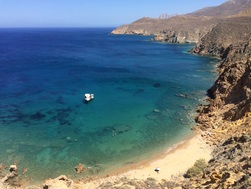|
According to Apollonius Rhodius’ “Argonautica”, the island was named Anafi because Apollo made it appear to the Argonauts as a shelter in a dark night, using his bow to shed light upon it (i.e. the island name Aνάφη is derived from ανέφηνεν, "he made appear”, the same root as phenomenon). The ruins of an Apollo temple are still discernable, serving as the foundation for an old monastery. A marble statue of Apollo found in Anafi is currently visible at the British Museum.
The Chora village, with its quintessentially Cycladic white-box houses, completes an environment of arid rock, lilac thyme flowers and sandy beaches. The Kalamos peninsula at the eastern end of the island is dominated by the second largest monolithic peak in the Mediterranean. Perched atop this massif is the Kalamiotissa church, a place of breath-taking views reachable after a one-and-a-half hour harrowing hike from the Apollo temple, a remote spot where clouds systematically form and vanish. Anafi was a place of exile for political prisoners throughout the Greek dictatorships of the 20th century. Anafi is a remote island that can be reached by an overnight boat from Athens. It can also be reached by a 90-minute boat from Santorini. Santorini has an international airport connected to several European cities. Anafi's official website |






